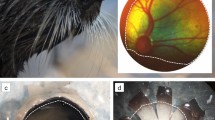Abstract
The ocean sunfish, Mola mola, is the largest known bony fish. Based on prior studies of diet composition, it is considered to be a pelagic zooplanktivore. However, a recent study using acoustic telemetry revealed that they repeatedly dive to depths of >50 m during the day. We examined the distribution of cells within the retinal ganglion cell layer in the immature ocean sunfish (c.a. 50 cm total length) and estimated their visual acuity with respect to the main visual axis and visual fields. Visual acuity was between 3.37 and 4.41 cycles/degree. The region of highest cell density was located in the dorso-temporal retina, indicating that the main visual axis of ocean sunfish is directed towards the lower frontal portion of the visual field. This axis is considered beneficial for detecting prey items when the sunfish are migrating vertically through the water column, and in foraging behavior near the sea bottom.




Similar content being viewed by others
References
Bailes HJ, Trezise AEO, Collin SP (2006) The number, morphology, and distribution of retinal ganglion cells and optic axons in the Australian lungfish Neoceratodus forsteri (Krefft 1870). Vis Neurosci 23:257–273. doi:10.1017/S0952523806232103
Bass AL, Dewar H, Thys T, Streelman JT, Karl SA (2005) Evolutionary divergence among lineages of the ocean sunfish family, Molidae (Tetradontiformes). Mar Biol (Berl) 148:405–414. doi:10.1007/s00227-005-0089-z
Bozzano A, Collin SP (2000) Retinal ganglion cell topography in elasmobranchs. Brain Behav Evol 55:191–208. doi:10.1159/000006652
Cartamil DP, Lowe CG (2004) Diel movement patterns of ocean sunfish Mola mola off southern California. Mar Ecol Prog Ser 266:245–253. doi:10.3354/meps266245
Collin SP, Pettigrew JD (1988a) Retinal topography in reef teleosts. I. Some species with well-developed areae but poorly-developed streaks. Brain Behav Evol 31:269–282. doi:10.1159/000116594
Collin SP, Pettigrew JD (1988b) Retinal topography in reef teleosts. II. Some species with prominent horizontal streaks and high-density areae. Brain Behav Evol 31:283–295. doi:10.1159/000116595
Collin SP, Pettigrew JD (1989) Quantitative comparison of the limits on visual spatial resolution set by the ganglion cell layer in twelve species of reef teleosts.. Brain Behav Evol 34:184–192. doi:10.1159/000116504
Fraser-Bruner A (1951) The ocean sunfishes (Family Molidae). Bull Br Mus Nat Hist 1:89–121
Fritsches KA, Marshall NJ, Warrant EJ (2003) Retinal specializations in the blue marlin: eyes designed for sensitivity to low light levels. Mar Freshw Res 54:333–341. doi:10.1071/MF02126
Gudger EW (1928) Capture of an ocean sunfish. Sci Mon 26:257–261
Hariston NG Jr, Li KT, Easter SS Jr (1982) Fish vision and the detection of planktonic prey. Science 218:1240–1242. doi:10.1126/science.7146908
Heffner RS, Heffner HE (1992) Visual factors in sound localization in mammals. J Comp Neurol 317:219–232. doi:10.1002/cne.903170302
Ito H, Murakami T (1984) Retinal ganglion cells in two teleosts species, Sebastiscus marmoratus and Navodon modestus. J Comp Neurol 229:80–96. doi:10.1002/cne.902290107
Matsuura K, Tyler JC (1998) Triggerfishes and their allies. In: Paxton JR, Eschmeyer WN (eds) Encyclopedia of fishes. Academic Press, San Diego, pp 227–231
Miyazaki T, Shiozawa S, Kogane T, Masuda R, Maruyama K, Tsukamoto K (2000) Developmental changes of the light intensity threshold for schooling formation in the striped jack Pseudocaranx dentex. Mar Ecol Prog Ser 192:267–275. doi:10.3354/meps192267
Murayama T, Somiya H (1998) Distribution of ganglion cells and object localizing ability in the retina of three cetaceans. Fish Sci 64:27–30
Nakatsubo T, Kawachi M, Mano N, Hirose H (2007) Estimation of maturation in wild and captive ocean sunfish Mola mola. Aquac Sci 55:259–264
Nelson JS (2006) Fishes of the world, 4th edn. John & Sons Inc, Hoboken, New Jersey
Shand J, Chin SM, Harman AM, Moore S, Collin SP (2000) Variability in the location of the retinal ganglion cell area centralis is correlated with ontogenetic changes in feeding behavior in the black bream, Acanthopagrus butcheri (Sparidae, Teleostei). Brain Behav Evol 55:176–190. doi:10.1159/000006651
Tamura T (1957) A study of visual perception in fish, especially on resolving power and accommodation. Bull Jap Soc Sci Fish 22:536–557
Acknowledgements
This study was supported by the Tokai Art and Science Foundation (2005) and a Grant-in-Aid for Scientific Research from the JSPS (No. 17570077). We thank Noriaki Yamashita and staff of the Shimakatsu Oshiki Co. Ltd. for allowing us to obtain the ocean sunfish.
Author information
Authors and Affiliations
Corresponding author
Rights and permissions
About this article
Cite this article
Kino, M., Miayzaki, T., Iwami, T. et al. Retinal topography of ganglion cells in immature ocean sunfish, Mola mola . Environ Biol Fish 85, 33–38 (2009). https://doi.org/10.1007/s10641-009-9453-z
Received:
Accepted:
Published:
Issue Date:
DOI: https://doi.org/10.1007/s10641-009-9453-z




